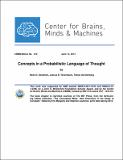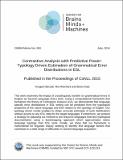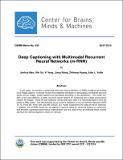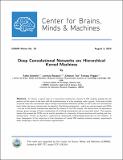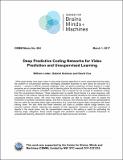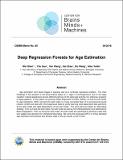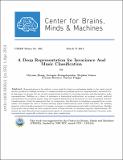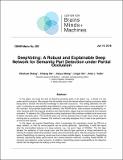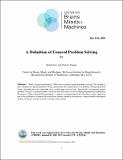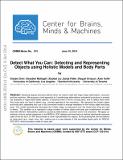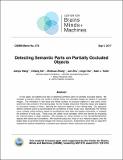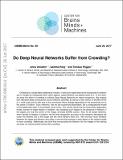Browsing Center for Brains, Minds & Machines by Title
Now showing items 21-40 of 151
-
Computational role of eccentricity dependent cortical magnification
(Center for Brains, Minds and Machines (CBMM), arXiv, 2014-06-06)We develop a sampling extension of M-theory focused on invariance to scale and translation. Quite surprisingly, the theory predicts an architecture of early vision with increasing receptive field sizes and a high resolution ... -
Concepts in a Probabilistic Language of Thought
(Center for Brains, Minds and Machines (CBMM), 2014-06-14)Knowledge organizes our understanding of the world, determining what we expect given what we have already seen. Our predictive representations have two key properties: they are productive, and they are graded. Productive ... -
Constant Modulus Algorithms via Low-Rank Approximation
(Center for Brains, Minds and Machines (CBMM), 2018-04-12)We present a novel convex-optimization-based approach to the solutions of a family of problems involving constant modulus signals. The family of problems includes the constant modulus and the constrained constant modulus, ... -
Contrastive Analysis with Predictive Power: Typology Driven Estimation of Grammatical Error Distributions in ESL
(Center for Brains, Minds and Machines (CBMM), arXiv, 2016-06-05)This work examines the impact of crosslinguistic transfer on grammatical errors in English as Second Language (ESL) texts. Using a computational framework that formalizes the theory of Contrastive Analysis (CA), we demonstrate ... -
Cross-validation Stability of Deep Networks
(Center for Brains, Minds and Machines (CBMM), 2021-02-09)Recent theoretical results show that gradient descent on deep neural networks under exponential loss functions locally maximizes classification margin, which is equivalent to minimizing the norm of the weight matrices under ... -
Deep Captioning with Multimodal Recurrent Neural Networks (m-RNN)
(Center for Brains, Minds and Machines (CBMM), arXiv, 2015-05-07)In this paper, we present a multimodal Recurrent Neural Network (m-RNN) model for generating novel image captions. It directly models the probability distribution of generating a word given previous words and an image. ... -
Deep compositional robotic planners that follow natural language commands
(Center for Brains, Minds and Machines (CBMM), Computation and Systems Neuroscience (Cosyne), 2020-05-31)We demonstrate how a sampling-based robotic planner can be augmented to learn to understand a sequence of natural language commands in a continuous configuration space to move and manipu- late objects. Our approach combines ... -
Deep Convolutional Networks are Hierarchical Kernel Machines
(Center for Brains, Minds and Machines (CBMM), arXiv, 2015-08-05)We extend i-theory to incorporate not only pooling but also rectifying nonlinearities in an extended HW module (eHW) designed for supervised learning. The two operations roughly correspond to invariance and selectivity, ... -
Deep Nets: What have they ever done for Vision?
(Center for Brains, Minds and Machines (CBMM), 2018-05-10)This is an opinion paper about the strengths and weaknesses of Deep Nets. They are at the center of recent progress on Artificial Intelligence and are of growing importance in Cognitive Science and Neuroscience since they ... -
Deep Predictive Coding Networks for Video Prediction and Unsupervised Learning
(Center for Brains, Minds and Machines (CBMM), arXiv, 2017-03-01)While great strides have been made in using deep learning algorithms to solve supervised learning tasks, the problem of unsupervised learning—leveraging unlabeled examples to learn about the structure of a domain — remains ... -
Deep Regression Forests for Age Estimation
(Center for Brains, Minds and Machines (CBMM), 2018-06-01)Age estimation from facial images is typically cast as a nonlinear regression problem. The main challenge of this problem is the facial feature space w.r.t. ages is inhomogeneous, due to the large variation in facial ... -
A Deep Representation for Invariance And Music Classification
(Center for Brains, Minds and Machines (CBMM), arXiv, 2014-17-03)Representations in the auditory cortex might be based on mechanisms similar to the visual ventral stream; modules for building invariance to transformations and multiple layers for compositionality and selectivity. In this ... -
Deep vs. shallow networks : An approximation theory perspective
(Center for Brains, Minds and Machines (CBMM), arXiv, 2016-08-12)The paper briefly reviews several recent results on hierarchical architectures for learning from examples, that may formally explain the conditions under which Deep Convolutional Neural Networks perform much better in ... -
DeepVoting: A Robust and Explainable Deep Network for Semantic Part Detection under Partial Occlusion
(Center for Brains, Minds and Machines (CBMM), 2018-06-19)In this paper, we study the task of detecting semantic parts of an object, e.g., a wheel of a car, under partial occlusion. We propose that all models should be trained without seeing occlusions while being able to transfer ... -
A Definition of General Problem Solving
(2020-07-13)What is general intelligence? What does it mean by general problem solving? We attempt to give a definition of general problem solving, characterize the common process of problem solving and provide a basic algorithm that ... -
Detect What You Can: Detecting and Representing Objects using Holistic Models and Body Parts
(Center for Brains, Minds and Machines (CBMM), arXiv, 2014-06-10)Detecting objects becomes difficult when we need to deal with large shape deformation, occlusion and low resolution. We propose a novel approach to i) handle large deformations and partial occlusions in animals (as examples ... -
Detecting Semantic Parts on Partially Occluded Objects
(Center for Brains, Minds and Machines (CBMM), 2017-09-04)In this paper, we address the task of detecting semantic parts on partially occluded objects. We consider a scenario where the model is trained using non-occluded images but tested on occluded images. The motivation is ... -
Discriminate-and-Rectify Encoders: Learning from Image Transformation Sets
(Center for Brains, Minds and Machines (CBMM), arXiv, 2017-03-13)The complexity of a learning task is increased by transformations in the input space that preserve class identity. Visual object recognition for example is affected by changes in viewpoint, scale, illumination or planar ... -
Do Deep Neural Networks Suffer from Crowding?
(Center for Brains, Minds and Machines (CBMM), arXiv, 2017-06-26)Crowding is a visual effect suffered by humans, in which an object that can be recognized in isolation can no longer be recognized when other objects, called flankers, are placed close to it. In this work, we study the ... -
Do Neural Networks for Segmentation Understand Insideness?
(Center for Brains, Minds and Machines (CBMM), 2020-04-04)The insideness problem is an image segmentation modality that consists of determining which pixels are inside and outside a region. Deep Neural Networks (DNNs) excel in segmentation benchmarks, but it is unclear that they ...


